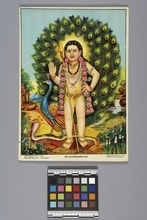Item number Eg278 from the MOA: University of British Columbia.
 Public
Public
Item Records
This page shows all the information we have about this item. Both the institution that physically holds this item, and RRN members have contributed the knowledge on this page. You’re looking at the item record provided by the holding institution. If you scroll further down the page, you’ll see the information from RRN members, and can share your own knowledge too.
The RRN processes the information it receives from each institution to make it more readable and easier to search. If you’re doing in-depth research on this item, be sure to take a look at the Data Source tab to see the information exactly as it was provided by the institution.
These records are easy to share because each has a unique web address. You can copy and paste the location from your browser’s address bar into an email, word document, or chat message to share this item with others.
- Data
- Data Source
This information was automatically generated from data provided by MOA: University of British Columbia. It has been standardized to aid in finding and grouping information within the RRN. Accuracy and meaning should be verified from the Data Source tab.
Description
Rectangular shaped print of Murugan standing with his right hand raised and left hand resting on hip. Gold lance in upright position crosses diagonally over body and rests against his right shoulder. Murugan is wearing a garland of roses and jewelry. Forehead is marked with two white lines and a red dot. Right hand is in abhaya mudra gesture. Encircling Murugan are the background tail feathers forming an aureole. A cobra is at his feet. In the far distance on left is a temple, on right, a waterfall.
History Of Use
Indian popular religious prints have been published for nearly a century, first by German presses, later by Indian ones. The prints may take the form of calendars, posters, or simply images. The style of the representations is European. In the beginning they were Hindu images, but are now acquiring elements both of folk art and a romantic secularism. It is a living art currently influenced by the movie industry and non-Hindu religions. The images are a vehicle for advertising and are also used for religious purposes. This print is for use in puja.
Cultural Context
calendar art; popular religious art
Iconographic Meaning
Symbols indicating Murugan (Subramaniyar): lance (vel), peacock, forehead marking in his association with Shiva as Shiva and Parvati's son, and abhaya-mudra gesture symbolizing reassurance.
Item History
- Made in India during 1930
- Collected before 1982
- Owned by Stephen Inglis before January 1983
- Received from Stephen Inglis (Donor) during January 1983
What
- Name
- Identification Number
- Eg278
- Type of Item
- Overall
- height 25.4 cm, width 18.0 cm
Where
- Holding Institution
- MOA: University of British Columbia
- Made in
- India
Who
- Culture
- South India
- Previous Owner
- Stephen Inglis
- Received from
- Stephen Inglis (Donor)
When
- Creation Date
- during 1930
- Collection Date
- before 1982
- Ownership Date
- before January 1983
- Acquisition Date
- during January 1983
Other
- Item Classes
- works on paper
- Condition
- good
- Accession Number
- 0857/0133
Ask a question
Let the RRN community answer your questions
 Public
Public
With an account, you can ask other users a question about this item. Request an Account
Shared Knowledge
Share your knowlege of this item with the RRN community
 Public
Public
With an account, you can submit information about this item and have it visible to all users and institutions on the RRN. Request an Account









